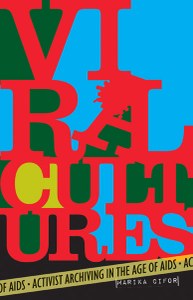Viral Cultures: Activist Archiving in the Age of AIDS
by Marika Cifor, Minnesota Press, 2022, 308 pp.
Cloth, $108.00; Paperback, $27.00; eBook, $14.85
ISBN: 978-1-5179-0936-9

Viral Cultures: Activist Archiving in the Age of AIDS by Marika Cifor is an intensive work of archival studies scholarship that examines and “activates” AIDS archives and the work of artists and activists through original analytics and methodologies, towards a more inclusive and generative present and future amidst HIV/AIDS. Viral Cultures is more than an approach to studying AIDS archives; it also serves as a detailed ethnographic account of the history of three major AIDS archives, the activists and artists who built those archives and passionately debated their futures, and the intimate nature of the archival process itself when it unfolds so close to life, and to death. The interviews, art analyses, vivid descriptions, critical investigations, and theoretical interventions in Viral Cultures would be a valuable resource for research in many fields, such as HIV/AIDS in America, the history of New York City, queer history, activist media, and art history. Because it is a post-2020 work of scholarship concerning a pandemic, there is the temptation to frame Viral Cultures in the context of COVID-19, but this would flatten the strength that comes from the book’s specificity. That being said, this work does contribute to an understanding of the emotional, academic, and political nature of archiving a pandemic, and Cifor’s findings and approaches inevitably relate to the present, both of the ongoing HIV/AIDS pandemic and of the COVID-19 pandemic.
At the core of Viral Cultures is “vital nostalgia,” the analytic introduced by Cifor: “A generative practice for interrogating, addressing, and repairing structural power inequities grounded in the bittersweet longing for a past time or space” (6). Cifor locates and employs vital nostalgia in and towards AIDS archives to insightful effect. Vital nostalgia is an affective practice for a subject that is often relegated to the past or the biomedical. Cifor’s work explores the entanglements of the intense emotions and labor of AIDS activists and the structural, institutional, and medical worlds of HIV/AIDS both now and in the past. The first chapter, “‘Your nostalgia is killing me!’: ACT UP Nostalgia and the Meaning of HIV/AIDS” examines uncritical nostalgia and the aestheticizing of ACT UP images and art online. This chapter considers the controversy concerning a 2013 poster featuring the phrase, “YOUR NOSTALGIA IS KILLING ME!” alongside iconic ACT UP images edited into a rendered teenage bedroom. Cifor analyzes this poster and the reactions to it from new generations of activists and artists in contrast to those of an older generation that experienced its context firsthand. This situation proves a productive microcosm for introducing the reader to the concept of “vital nostalgia” and how it differs from conventional nostalgia and romanticization. Cifor thinks through this poster to question what the archive means in the age of social media and “the dangers of digital decontextualization and related commodification” (67). The many elements and perspectives are overwhelming at first, but Cifor’s guidance through the contexts allows an effective approach to the temporal, theoretical, and affective complexities that arise in the rest of the book. In Viral Cultures the artistic, the bodily, the emotional, and the scholarly are equal producers of meaning for archival studies.
The reality of all of Cifor’s investigations is that the New York AIDS archives (mainly the New York Public Library, NYU’s Fales Library and Special Collections, and Visual AIDS) as well as the mainstream imaginary of HIV/AIDS has excluded the narratives of cis and trans women, Black, brown, Indigenous, undocumented people, and incarcerated people, among others who continue to face difficulties accessing care. Cifor continually restates the stakes of the archive: “If not done carefully, it powerfully recenters gay, white, middle-class men; it informs who and what is accounted for and who is excluded from dominant AIDS narratives; and it reproduces the historical belonging they enact” (92).
Chapter three, “An Archival Cure: Remedy, Care, and Curation with the Visual AIDS Archive Project” follows one of Cifor’s more poetic experiments with understanding “cure” as deeper and more culturally complex than medicine alone. This chapter discusses connections between understandings of a “cure” and the role of “curators” within an HIV/AIDS context through the lens of “vital nostalgia,” which “enables a more complicated understanding of archives” (6). Cifor’s vital nostalgia analytic mobilizes the archive and temporal disruptions, with the potential “to realign AIDS time in ways that expose its uneven valences and reset its social rhythms” (16). Cifor also proposes “undetectability” as a curatorial methodology “grounded in care work” in chapter four, “Status = Undetectable: Liminality and Archival Exhibitions in the Age of Survivability.” This methodology renders the undetectable into a site of visibility, allowing “previously undetectable” AIDS archival records to become visible, and making space for further potentialities.
The final chapter, “Going Viral: Mobilizing AIDS Archives in Digital Cultures” and the epilogue, “How to Survive Another Plague,” bring the AIDS archive into the present of digital media and COVID-19. Cifor analyzes the work of a new generation of artists and activists creating through digital culture and social media. Cifor discusses the meaning of the viral in online AIDS activism, writing that “virality has become a prime organizational logic of networked digital culture” and employing it as a critical activist tool alongside vital nostalgia (198). In the epilogue, vital nostalgia evolves beyond an archival analytic and becomes a living tool for reworking and understanding the present towards building multiple, less discriminatory futures. “Records hold power that is harnessed by activists, artists, curators, and archivists through vital nostalgia to repoliticize AIDS and reinvest AIDS time with palpable urgency” (232). Viral Cultures reaffirms the importance of critical, inclusive, just, and examined archives as society continues through multiple pandemics, and Cifor offers original and generative analytics and methodologies to guide and produce these practices and research.
Camille Coy, New York University

